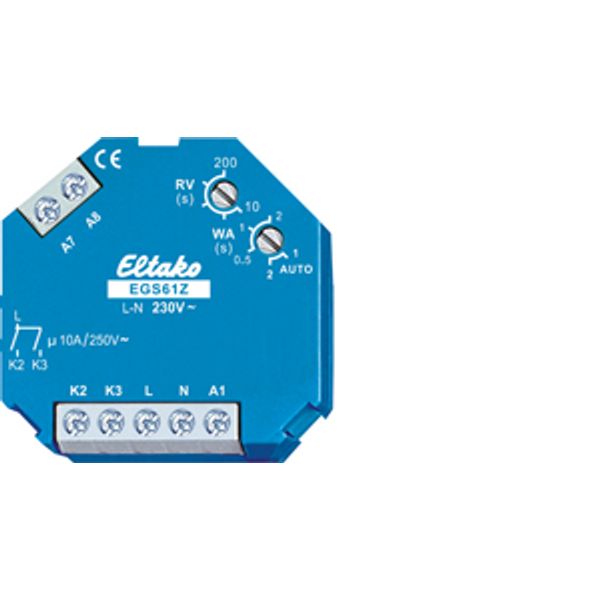Registruokitės, kad atrakintumėte savo išskirtines B2B kainas ir pradėtumėte apsipirkinėti. Užsiregistruokite dabar!
Impulse group switch, 1+1 NO contacts 10A
Yra sandėlyje: Ne
Pardavėjo atsargos: Ne
Minimalus užsakymo kiekis: 1
Kaina (be PVM):
46,05 €
EAN: 4010312108123
MPN: 61200430
Pakuotė: 1
Numatomas pristatymo laikas į mūsų sandėlį (apytiksliai):
Pagal užklausą
Technical Information
| Prekės būklė | Nauja |
| Gamintojo pavadinimas | Impulse group switch, 1+1 NO contacts 10A |
| Prekės ženklas | ELTAKO |
| Kategorijos |
Relės
|
| Kilmės šalis | CN |
| Suderintos sistemos kodas | 8536 5080 00 |
| Montavimo metodas | Viršutinis sluoksnis (tinko) |
| Funkcija | Elektroninis grupės jungiklis |
| Suprojektuotas gylis | 32 mm |
| Modulinių tarpų skaičius plotyje | 3.1 |
| 1 kontrolinė įtampa | 230 V |
| 1 kontrolinės įtampos tipas | Kintamoji srovė |
| 1 kontrolinės įtampos dažnis | 50 Hz |
| Rankinė operacija | No |
| Tiekimo įtampos tipas | Kintamoji ar nuolatinė srovė |
| Maitinimo įtampos diapazonas | 230 V |
| Nominali jungiklio srovė | 16 A |
| Įprastai uždarytų kontaktų skaičius | 0 |
| Įprastai atvirų kontaktų skaičius | 2 |
| Perjungimo kontaktų skaičius | 0 |
Pakavimo informacija
| Pakavimo lygis 1 | 4010312108123, 4010312108123 |
| Pakavimo lygis 2 | 4010312108123 |
| Pakavimo lygis 3 | 4010312108123 |
Atsisiuntimai
Aprašymas
Impulse group switch for central control, 1+1 NO contacts not potential free 10A/250V AC, for one 230V AC motor. Standby loss 0.4 watt only. For installation. 45mm long, 45mm wide, 32mm deep. State-of-the-art hybrid technology combines advantages of nonwearing electronic control with high capacity of special relays. This impulse group switch serves to implement commands generated by the sensor relays or by switches and push-buttons and controls a 230V motor for a shading element or a roller shutter. Control, supply and switching voltage 230V. The same control voltage must be supplied to A1, A7 and A8 as to L. By using bistable relays coil power loss and heating is avoided even in the on mode. The switched consumer may not be connected to the mains before the short automatic synchronisation after installation has terminated. A universal pushbutton connected to control input A1 controls the pulse signals for up, stop, down, stop. As of production week 25/18, a direction pushbutton for down can be connected via the diode RTD (any polarity). Another direction pushbutton for 'up' is connected directly to A1. On the first control pulse down, EGS61Z switches over the control input A1 to 'direction pushbutton'. To switch the control input back to universal pushbutton, briefly switch off the power supply and switch back on. Additional control inputs A7 and A8 can be used for central control UP or DOWN with priority. With priority because these control inputs cannot be overridden by other control inputs as long as the central control contact is closed. Up or DOWN is activated by a control signal. A further control signal (< 700ms) at this control imput interrupts this process immediately, a further control signal (> 700ms) continues the process. The time delay (delay time RV) is set by means of the rotary switch RV. If, the group impulse switch is in the UP or DOWN position the selected delay time runs (elapses). At time-out the device changes automatically to STOP. Therefore, the time delay must be chosen at least as long as the shading element or roller shutter will need to move from one limit position to the other. With the rotary switch WA automatic reversal is controlled: in the setting from 0.5 to 2 sec. reversal time the automatic reversal is activated. In this case, it is only for DOWN that the direction is reversed on time-out of the time lag selected by means of the top rotary switch RV, e.g. to extend awnings or set Venetian blinds to a defined position. AUTO 1: No automatic reversal and no local advanced automatic reversing system. A7 and A8 operation < 1s: static process (contact closes only during operation) operation > 1s: dynamic process (contact remains closed), stop command by new operation. AUTO 2: Automatic reversal with 1s reversal time. Additionally the local advanced automatic reversing system for Venetian blinds at A1 is active: a double impulse activates a slow rotation in the opposite direction, which can be stopped with a further impulse.

